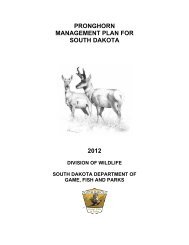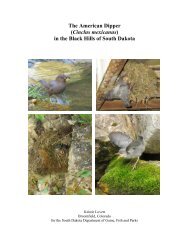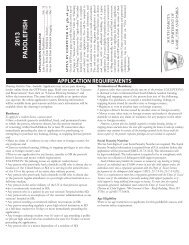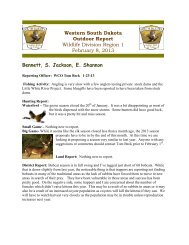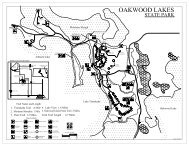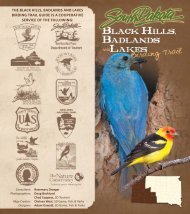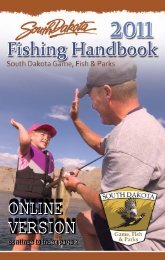pdf version - South Dakota Department of Game, Fish and Parks
pdf version - South Dakota Department of Game, Fish and Parks
pdf version - South Dakota Department of Game, Fish and Parks
You also want an ePaper? Increase the reach of your titles
YUMPU automatically turns print PDFs into web optimized ePapers that Google loves.
Emerald Shiner<br />
Notropis atherinoides<br />
Quick key characteristics: The emerald shiner is found in cool-water<br />
habitats. It has large, silvery, deciduous scales. Fins are s<strong>of</strong>t with short bases,<br />
its mouth is forward-facing, <strong>and</strong> its snout is pointed. Its body is somewhat<br />
taller than wide, but less so compared to most minnows.<br />
Similar species in <strong>South</strong> <strong>Dakota</strong>: other minnows, especially carmine <strong>and</strong><br />
silverb<strong>and</strong> shiners<br />
Identifi cation: The combination <strong>of</strong> (1) a long, slender body, (2) dorsal<br />
fi n set well behind pelvic fi ns, (3) large, terminal mouth, <strong>and</strong> (4) large eye<br />
differentiates the emerald shiner from most other minnows in <strong>South</strong> <strong>Dakota</strong>.<br />
The carmine shiner is similar, but has a longer snout, rosy coloration, more<br />
rounded dorsal fi n, <strong>and</strong> is restricted to streams <strong>of</strong> the Minnesota River<br />
drainage in far eastern <strong>South</strong> <strong>Dakota</strong>. The silverb<strong>and</strong> shiner is similar, but<br />
has a slightly shorter anal fi n, is only known from the mainstem Missouri<br />
River <strong>and</strong> larger tributaries, <strong>and</strong> may no longer be present in the state.<br />
Range: The emerald shiner is native to most <strong>of</strong> central North America<br />
between the Appalachian <strong>and</strong> Rocky mountains, including rivers that fl ow<br />
into the Hudson Bay <strong>and</strong> Arctic Ocean. It is widespread in larger streams,<br />
rivers, impoundments, <strong>and</strong> lakes in <strong>South</strong> <strong>Dakota</strong>.<br />
Items <strong>of</strong> interest:<br />
• Common prey for sport fi sh because<br />
it <strong>of</strong>ten forms large schools <strong>and</strong><br />
frequents open water<br />
• Feeds on plankton, insects,<br />
crustaceans, <strong>and</strong> algae<br />
• May exceed 6 in<br />
24








